3 September: Day 1
In the wise words of Miss Julie Andrews:
Let's start at the very beginning
A very good place to start
When you read you begin with A-B-C
When you sing you begin with do-re-mi
But when you go to Bolivia, you begin with a d-r-i-n-k!

Hoorah! We're on holiday! Only downside is we haven't got a window
seat :-(
[We will later find out that our BA frequent-flyer cards haven't
been registered for the booking, which probably explains it.]

Obviously one eats Japanese food in Peru between planes. We knew
they'd had a Japanese president, but it seems there's quite a long
Japanese history in Peru. A touch contentious, though? Wikipedia's
article at https://en.wikipedia.org/wiki/Japanese_Peruvians
starts off ominously, "This article
has multiple issues."
4 September: Day 2
We arrive in La Paz not that long after midnight, but although
we consider it to be night-time and go to bed, technically the
hotel considers it an early check-in, not a night's stay.

Next day, or later the same day depending on perspective, we
have a city tour. This is the tomb of Andrés de Santa Cruz,
president at various times of Peru, Bolivia and the Peru-Bolivia
Confederation. He managed ten years as Bolivian president, when
hanging on for more than a couple of months had been beyond some
of his predecessors!
But enough of the history lesson, I'm really just taking a picture
of men in shiny red uniforms.

So to another world, the "Witches' Market". Note the toy animals
hanging down from the awnings. They're not toy animals at all,
they're stillborn llama foetuses. As I'm sure you know, when you
build a house, you need to give Pachamama - Mother Earth -
a little present, and it seems she's fond of llama foetuses (as
well as strong drink, cigarettes, etc). Actually, my own mother
was fond of strong drink and cigarettes, but I'm pretty sure a
llama foetus would have been declined as politely as she could
manage.
5
September: Day 3

This is "Moon
Valley" just outside La Paz, an otherworldly landscape of rocks
that look almost like mud stalagmites. It's caused by rain
erosion, but it looks like a decent shower would wash the whole
thing away! Allegedly, the name was bestowed by Neil Armstrong
when he visited the area, but this is almost certainly made up
to fool gullible tourists.

Back in town, we
ride the cable car. The streets of La Paz are completely choked
with traffic for most of the day, and this is the quickest way
to get around by far if your journey suits the available lines.
By contrast with the buses and taxis - old, overcrowded and
polluting - this network would do any Green-minded first world
city proud. Oh, and this stop has a kiosk where they sell the
best cheese empanadas in town! Yummy :-)
6 September: Day 4

We're off to the Amazon basin now, starting in the town of
Rurrenabaque on the Beni river. There are not that many roads
here, and certainly no bridges!
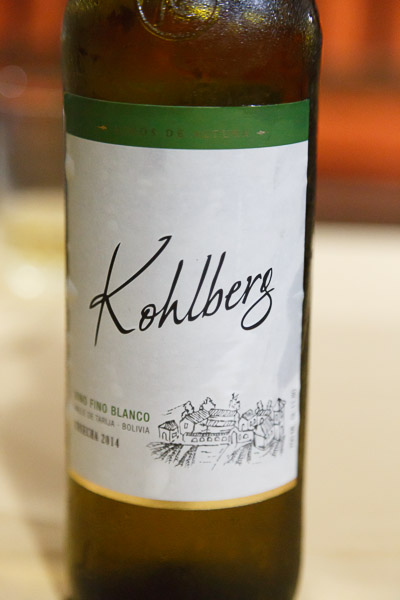
And Bolivian wine! It's probably not going to win any
international awards, but it turns out a lot better than we'd
feared. We're not sure what grape it is, but it strongly resembles
a dry Muscat.
7
September:
Day 5
Happy Birthday to Me!
We're off upriver to the Lake Chalalán ecolodge, run by members of
a forest community which goes under the unlikely name of San José
de Uchupiamonas.

The water is so shallow in places that the propeller has to be
lifted out of the water and the crew jump over the side and start
pushing! We can see that it's hard work and the river is flowing
strongly against them. We are sharing the boat with another
couple, and at one point the bloke grabs a pole and starts
pushing, punt-style, but we decide it's best not to interfere with
people who clearly know what they are doing. That's our story and
we're sticking to it.
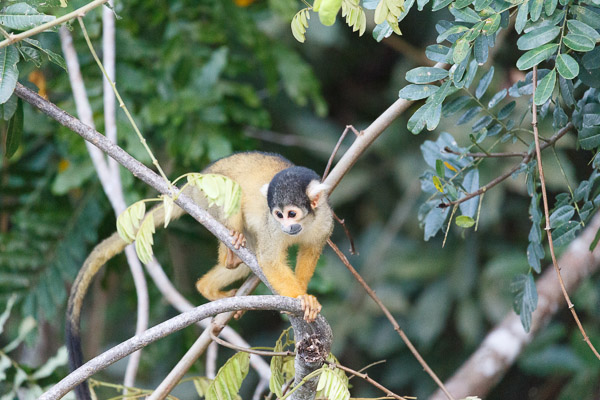
Later at the lodge, we go for a little boat ride on the lake and
spot Yellow Squirrel Monkeys amongst other wildlife.
8 September: Day 6
In the Amazonian rain forest...

Walking near the lodge, we see this fine tortoise.

And at night on the lake, a Cayman, perfectly reflected in the
water.
9 September: Day 7
Back on the river to Rurrenabaque and our return flight to La
Paz. We've had the flight changed twice from our original
itinerary, but hopefully the local guys know what they're doing!
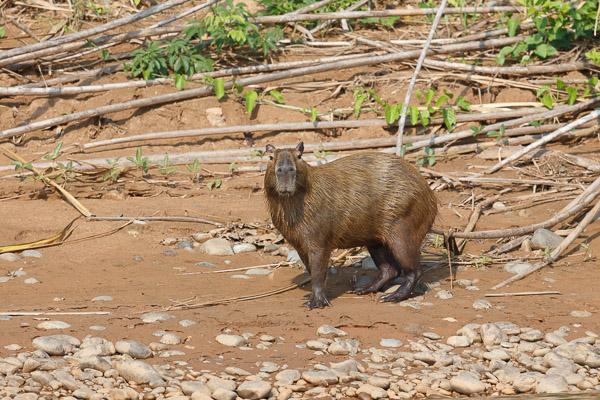
"You looking at me?" It's a capybara, the world's largest
rodent, and allegedly declared to be a fish by the Pope so that
Catholics could eat it on Fridays. Sadly, though, this too appears
to be apocryphal.
With the current, the return trip takes half the time of the
outward journey. The plane does indeed leave at the most recently
stated time, although the second change hasn't been passed on to
the guide meeting us at La Paz, so we have to call him when we
arrive. It only takes him ten minutes to get to the airport
though, barely enough time for us to have a coffee. [Aside:
Alexander Coffee at La Paz airport is very good: recommended if
you're passing that way.]

From the cable car, you get a really good view of La Paz
inside the bowl formed by the mountains.
10 September: Day 8
Today we will ride bicycles down the quaintly named "El
Camino de la Muerte", which sounds so much nicer than its
English translation, "The Road of Death". Once it was the only way
to get from A to B, and trucks and buses would drive it at lethal
speeds, making the name entirely appropriate as they used to have
2-300 fatalities a year! Now a new and much safer road has taken
virtually all of the traffic, so it's become a major tourist
attraction to ride down.

Oh look, we're passing a little monument where some people
have died...
It's perfectly safe if you don't do anything stupid and your bike
is in good condition, but there are stupid people and not
all the tour companies are as responsible as they should be. Our
company, Gravity, is the longest established with a 100% safety
record over many years and thousands of riders, but while there
are no official figures, estimates suggest around one death a year
on average over the last couple of decades.
But it's ok, we've got helmets!
[Photo courtesy Gravity, not an out-of-body experience.]

Amanda splashes through a small river that just flows straight
across the road, while guide Jorge waits taking pictures of
everyone.
11
September:
Day 9
Right, we've done rivers, we've done roads, let's do something
different...

Yep, that's a good idea, an Airstream camper in the middle of
the Salar de Uyuni salt flats. 12,000 square km of, well,
salt!
"It's camping, Jim, but not as we know it."
Actually, we're not totally in the middle of nowhere, as a picture
from a different angle would show. As well as the support crew's
tents and vehicles, there are villages and other points of
interest not too many miles away. It's still a fabulous
environment though, definitely worthy of that much abused word,
"unique". In many ways, this is what we've come to Bolivia
for, because just about everything else on our trip has
equivalents in other countries.
It's tempting to break the two-a-day rule here, but I shall be
strong. Artistic integrity is everything. I mean, Shakespeare
never said, "Damn, fourteen lines just isn't enough for this
sonnet", now did he?

At the edge of the salar, flamingoes wade in shallow lakes.
12 September: Day 10
Our second day on the salar.

Another astonishing sight. This looks like a mixture of cobwebs
and bat wings, but it's stone formations in a cave. It must be
some kind of fossilised organic structures, but our guide can't
tell us much and we understand that the place has never been
investigated by scientists. It was only discovered a few years ago
by some children playing in the hills, and although the local
villagers have installed some lights (powered by a slightly
temperamental portable generator) and charge a small admission
fee, it can't have seen many tourists. In all honesty, it feels
too fragile to sustain serious visitor numbers, so we really hope
it's looked after properly.
We've seen a lot of caves over the years but never anything like
this.

And so we say goodnight to the salar.
13
September:
Day 11
From a salt lake to a more conventional water lake - but not that
conventional. Yes, it's Lake Titicaca, nearly four kilometres
above sea level.
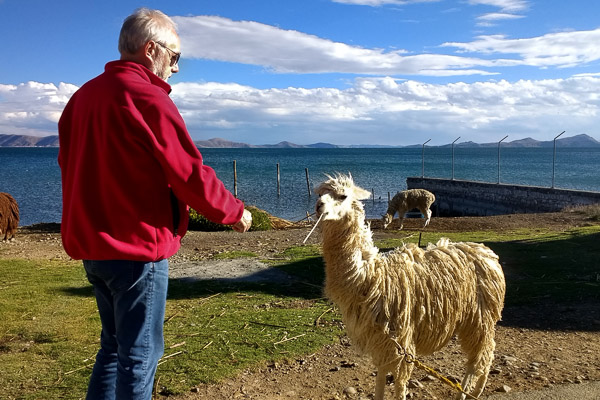
The hotel by the lake has a small model village attached. It's a
bit artificial looking, but the alpacas are friendly, at least if
you feed them. Fortunately, alpacas seem happy to eat any old bits
of stalk picked up off the ground just out of their reach, so
their friendship is easily attained.
Bolivia, you may know, has a Navy despite being landlocked. I am
under the vague impression that they do actually have some boats
on Lake Titicaca, so at dinner I ask our guide, Gustavo, if we
might see any evidence of the Navy on the lake. The waiter who is
already halfway out of the dining room almost collapses in
laughter on the spot! Oh dear, seems the Armada Boliviana
don't get no respect. Gustavo's
brother is in the Navy as it happens, and it sounds like he takes
the piss mercilessly.

Clouds are gathering. Later, there will be a substantial
electrical storm and we are not too sure what tomorrow will bring
weatherwise. They tell us that it often rains at night, but rarely
during the day in the summer... except that the rainy season
appears to be starting early this year. It may be global warming,
but we can't entirely avoid the thought that it's actually us,
because we have lost count of the number of times we've been told
all around the world, "It's never normally like this!"
True, we have form: we were in the USA for 9/11, Cambodia for the
tsunami, we got off a plane in Burma just before it crashed...
14
September:
Day 12
Our second night on Lake Titicaca will be spent on Sun Island,
which involves a drive to Copacabana (no, not that one) and a
hydrofoil ride.

Just outside the Basilica of Our Lady of Copacabana, people bring
their newly bought cars to be blessed. And just to be safe, after
the priest has given them God's stamp of approval, they'll check
in with Pachamama and a local shaman. Lonely Planet
reckons this is cheaper than insurance, but we're not convinced
you'll get to keep your no-claims bonus.

Sun Island - La Isla del Sol - is according to legend the
birthplace of the first Inca and home of the sun god. If somebody
showed you a picture and said it was a Greek island, though, you'd
be hard pressed to prove them wrong. But for the fact that it's
4000m up, so oxygen is short and the air is cold even when the sun
is burning, it really could be a Mediterranean scene.
15
September:
Day 13

The whole island is completely unsuited to motor vehicles, so
villagers can only use animals. Llamas, of course, do spoil the
Greek lookalike effect. The sun appears to have left home too.

This is not a high tech marina - pushing the hydrofoil away
with a stick!
16
September:
Day 14
We return to La Paz for the last time today, before flying
home. The roads are
constantly being disrupted by
protests, so as with virtually every other trip, we will have to
take some extra time for detours. In principle, we could have gone
direct from Sun Island without last night's hotel stay, but it
would have been a very long journey even if nothing went wrong,
and Bolivia is not the place to assume nothing will go wrong!
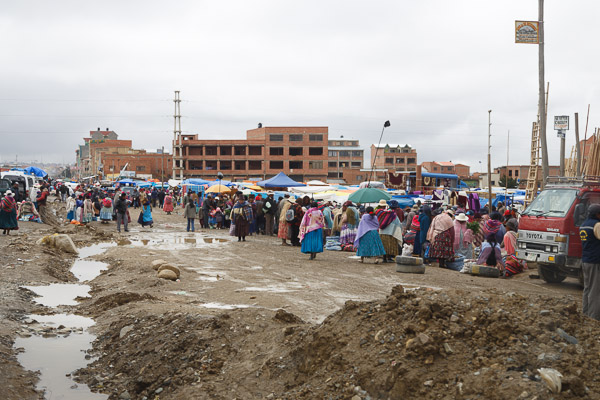
A detour takes us past a market in one of the poorer areas. The
indigenous people still mostly draw the short straws, although we
understand that things are changing now. Evo Morales, the
president, is of indigenous background himself although there
seems to be some dispute over just how close he is to his roots.
Everyone we speak to seems at the very least ambivalent over his
presidency, recognising that he did many good things in the early
years, but worried that power may be corrupting him now. Yet there
doesn't seem to be any better-favoured candidate, so everyone
seems a bit stuck.
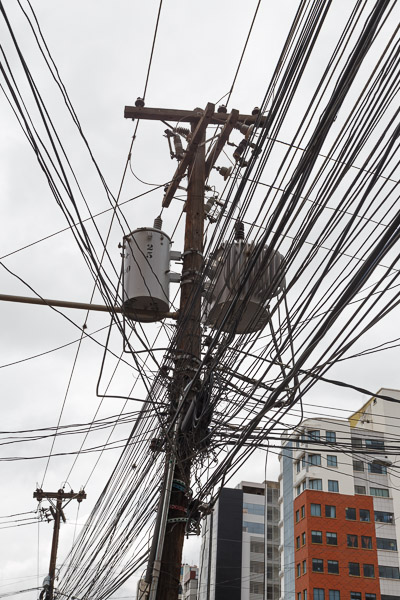
Ah, that old Third World street wiring! And this is in a good
neighbourhood.
On the one hand, it's a bit of a pity that we've had to go back
and forth through La Paz so many times, but looking on the bright
side, in five nights' accommodation we've received three free
welcome drinks at the bar :-)
17
September:
Day 15
Another early departure - 5:30 am - for the flight from La Paz to
Lima, after which we will have something like twelve hours to kill
before our flight back to Britain. Talking to our guide Erich
previously, he recommended that we get a taxi into the Miraflores
district of Lima for the day, and visit the Larco Museum and
Larcomar shopping mall. The latter is apparently right by the sea
and has great views as well as good food and upmarket shops.

Pre-Columbian flower-pot men! They are ceremonial vessels, for what
it doesn't say, and if I remember the caption correctly, they are
made of gold, copper/silver alloy and silver from left to right.
This is the Larco museum, a guide-book highlight definitely worth
visiting. Mind, you might want to take ear plugs if you actually
want to be able to concentrate on the exhibits. God, the noise
of the tourists and tour guides! It's better a few galleries away
from the entrance, perhaps for the same reason that many natural
beauty spots are all but deserted fifty yards from the car park.

The museum cafe is highly recommended by the book too, and again we
have to agree. Lunch is definitely the best food we've had all
holiday! A Michelin-starred place called "Gustu" was near our hotel
in La Paz and was recommended to us more than once, but we never
managed to find the time and the energy simultaneously. One of our
Death Road group had eaten there and raved about the tasting menu
for about Bs 600, or under seventy quid, which sounded a ridiculous
bargain by London standards!
Ah well, a pity, but ultimately we came to Bolivia for things we
can't find so easily in the Home Counties :-)
Afterwards, we take a short walk to the Anthropological Museum,
which is not quite so posh but still interesting, and then decide we
can't really be bothered to check out the Larcomar mall. If the sun
was shining, the sea might look pretty, but it's overcast and we
really can't get too excited by the idea of a bunch of shops. Back
to the airport, then, a little earlier than planned, but honour has
been satisfied.
(Now technically, the next day is also part of the trip, but you
all know what the inside of an aeroplane looks like, and Gatwick
South Terminal isn't going to leave anybody feeling uplifted or
envious of our good fortune, so we'll just quietly ignore it.)
So that's Bolivia on Two Pictures a Day.
It's only scratching the surface, of course, and there's loads more
to show and tell, but thirty thousand-word pictures and a good few
actual words will have to be enough for now.
¡Hasta luego amigos!
Steve.